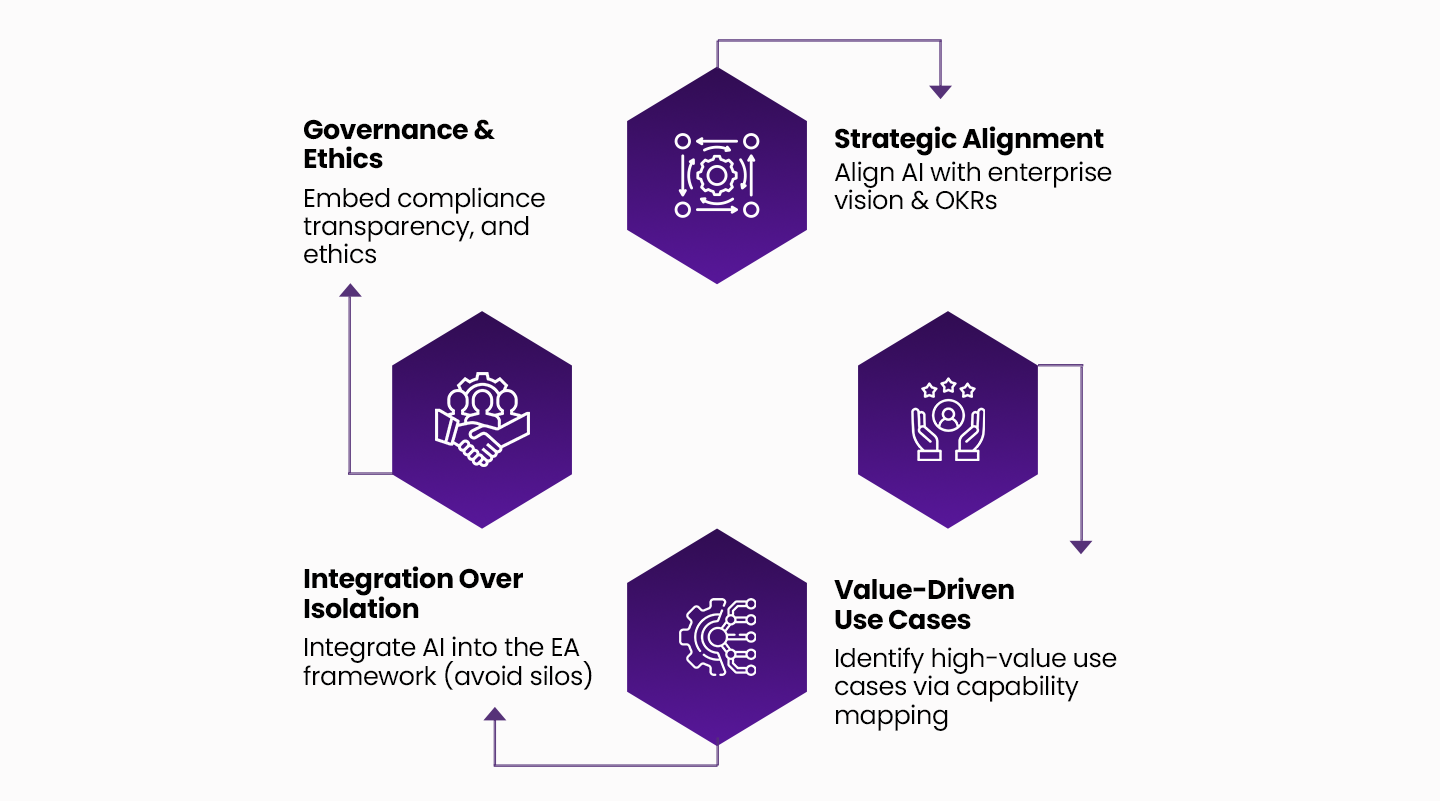Empowering the enterprise: AI enablement through enterprise architecture
Syed Aun Haider Enterprise Solution Architect - Systems Limited
September 29, 2025
AI is no longer “something for the future.” It’s here, shaping industries right now — from retail to healthcare, from manufacturing to finance. Organizations successfully integrating AI into their core operations unlock significant strategic advantages, such as improved decision-making through data-driven insights, enhanced operational efficiency through automation, and a competitive edge in rapidly changing markets. AI empowers leadership to anticipate market trends, personalize customer experiences, and optimize resource allocation, all while reducing operational costs. Enterprise Architects (EAs) play a crucial role in making this happen. Why? because EA provides the blueprint for aligning AI with business vision, processes, data, and technology. We ensure AI isn’t just a cool tool — it’s a strategic enabler.
From strategy to reality: Why EA matters in AI enablement

Strategic alignment
Every AI initiative should have a clear link to the company’s big-picture goals, whether those are the official OKRs (Objectives and Key Results), strategic priorities, or major transformation programs. This means AI projects shouldn’t be launched just because the technology is interesting or trending. Instead, they must be designed to deliver outcomes that directly support the
organisation’s vision. For example, if the business goal is to enhance customer personalization, the Enterprise Architecture (EA) team would identify AI-powered recommendation engines as a strategic initiative. This ensures the investment in AI directly improves customer experience, aligns with business priorities, and contributes measurable value to the company’s transformation journey.
Capability mapping and value-driven use cases
Capability mapping is a structured approach used to identify the parts of a business, whether specific processes or broader functional areas that would benefit the most from AI. Instead of spreading AI initiatives thinly across the organization, capability mapping helps focus efforts where they will create the greatest measurable impact. This ensures AI investments are directed toward solving real problems, optimizing performance, and unlocking new opportunities.
AI use cases
Below are key use cases where leveraging AI can help organizations drive maximum value.
1. Manufacturing sector
In manufacturing, AI can power predictive maintenance, allowing real-time detection and resolution of issues in the existing equipment before they cause downtime. This not only reduces unexpected delays but also lowers maintenance costs.
2. Banking and Finance
AI-driven fraud detection systems support bankers and financial experts by analyzing transaction patterns in real time to flag suspicious activity. By doing so, they help prevent losses and protect customer trust.
Also visit: Supercharge banking and create digital-first experiences
3. Retail and supply chain management
Forecasting product demands has been a real challenge for retailers, but with AI organizations can significantly improve inventory planning, by detecting purchase patterns and potential demand of the produce in the existing and future markets. This ensures products are available when customers need them, while minimizing overstock and waste.
By aligning AI adoption with business capabilities through capability mapping, organizations can maximize return on investment, accelerate adoption, and avoid wasting resources on initiatives that add little strategic value.
Governance & ethics
AI adoption must always comply with relevant privacy laws, such as the General Data Protection Regulation (GDPR) in Europe and the California Consumer Privacy Act (CCPA) in the United States. These regulations set clear requirements for how personal data can be collected, stored, processed, and shared, ensuring individuals’ rights are protected. Beyond legal compliance, AI integration must comply to fairness principles, meaning it should avoid bias, treat all users equitably, and produce decisions that are explainable and transparent. Adhering to recognized industry standards helps maintain consistency, quality, and trust in AI systems.
This is where Enterprise Architects (EAs) play a critical role. They design and enforce the guardrails that keep innovation on track, making sure that in the pursuit of new capabilities, organizations do not compromise on privacy, fairness, or ethical responsibility. By embedding these principles into the architecture and governance framework, EAs ensure AI is both innovative and trustworthy.
Integration over isolation
One of the biggest mistakes organizations make when introducing AI is treating it as a separate, standalone tool rather than embedding it into existing business and technology systems. Integration over isolation means ensuring AI capabilities are seamlessly connected to core processes, applications, and data flows so they enhance and extend the enterprise’s overall architecture instead of operating in a silo. For example, an AI-powered chatbot should not exist only as a standalone web widget but should also be integrated with the company’s CRM to access customer history, connected to the knowledge base for accurate responses, and linked to order management systems for real-time status updates. Similarly, predictive analytics should feed directly into planning tools, inventory systems, and dashboards, ensuring insight driven actions take place across the organization.
Moreover, by prioritizing integration, enterprises can avoid duplication of effort, ensure AI outputs are fully utilized, and maximize return on investment. This approach also improves governance and data consistency, making AI adoption more sustainable and aligned with the overall enterprise architecture strategy.
Architecting the AI-ready enterprise

Business layer – Where the "why" lives
Identify the business capabilities where AI can deliver the most impact, such as customer insights or logistics optimization, and clearly define the expected value, whether that means boosting revenue, lowering costs, or enabling faster and more informed decision-making. This clarity ensures AI investments are focused on areas that directly support strategic objectives.
By quantifying the potential benefits before starting, organizations can prioritize the right initiatives, allocate resources effectively, and measure success over time.
Application layer – Enablers of AI adoption
Modernizing applications with API-first approach, microservices, AI adoption and cloud-native principles ensure they are flexible, scalable, and ready to integrate with emerging technologies. By designing systems to communicate through APIs and breaking them into smaller, independent microservices, organizations can add new features or connect to external tools without major disruptions.
Integrating AI capabilities into modern architecture enables applications to transform data into actionable insights to make intelligent, real-time decisions. For example, an AI-powered chatbot can seamlessly connect with core enterprise systems such as CRM, ERP, and inventory management, enabling it to access customer history, check order statuses, and provide accurate responses instantly. This level of integration not only enhances efficiency but also improves customer experience and operational agility.
Data layer – Fuel for AI
AI's effectiveness is directly tied to the quality of the data it learns from; accurate, relevant data is crucial for driving meaningful insights and decisions. Organizations should maintain high-quality, well-governed datasets across structured, unstructured, and streaming sources to ensure accuracy, consistency, and compliance. Implementing data catalogs, lineage tracking, and metadata management helps organize and control data, providing the strong foundation needed for AI to deliver trustworthy and actionable results.
Technology layer – The AI platform foundation
Organizations can leverage cloud AI services such as Azure, AWS, or GCP for scalable, on-demand computing power that supports rapid deployment and global reach. Edge AI enables real-time, low-latency decision-making by processing data closer to its source, which is critical for time-sensitive applications like autonomous systems or IoT devices. Hybrid AI models combine both cloud and edge capabilities, helping organizations meet performance needs while adhering to regulatory compliance and data residency requirements.
Ensuring robust AI security and governance
Incorporating bias detection, value-driven dashboards, and secure model deployment pipelines helps ensure AI solutions are fair, transparent, and protected from vulnerabilities. To further
safeguard outcomes, organizations should embed AI risk assessments into their architectural review process, enabling early identification and mitigation of potential compliance, ethical, or operational risks before deployment.
From blueprint to business impact

Start small, scale fast
Start with small, high-impact AI pilots that offer quick returns, allowing you to validate the approach before scaling. For example, run a 3-month chatbot pilot in customer service to improve response times and measure customer satisfaction before rolling it out enterprise-wide.
Establish an AI governance board
Develop a cross-functional team that brings together expertise from Business, IT, Data Science, and Compliance experts to guide AI adoption. This group ensures every initiative is strategically aligned, technically feasible, ethically sound, and compliant with relevant regulations, creating a balanced and well-governed approach to implementation.
Integrate with transformation programs
AI should be integrated as part of larger digital transformation efforts, not treated as a standalone project. Embedding it into broader initiatives such as ERP modernization, eCommerce upgrades, and supply chain transformation ensures that AI capabilities enhance core systems, improve operational efficiency, and deliver business value at scale while aligning with overall strategic objectives.
Set the right KPIs to track progress
Establish realistic KPIs to effectively track AI’s impact across the organization. For instance, when measuring enhanced customer experience, focus on metrics like quicker issue resolution and more personalized interactions. For cost optimization, focus on reducing wastage and automating repetitive processes. In terms of innovation speed, measure how quickly new AI-enabled products or features move from concept to market, ensuring technology investments translate into tangible business results.
Continuous evolution
AI maturity develops in stages, starting with experimentation, progressing to operationalization, and ultimately becoming a core capability across the enterprise. Regularly reviewing architecture and updating it for new models, regulations, and opportunities helps sustain growth and ensure continued relevance.
Key takeaway
Enterprise Architects aren’t just technology planners, they are strategic AI enablers, ensuring AI adoption is:
Responsible – Compliant and ethical
Aligned – Connected to business goals
Scalable – Ready for enterprise-wide adoption
Impactful – Measured through meaningful outcomes
Organisations that thrive will be those where enterprise architecture effectively steers AI initiatives from initial hype to tangible business value. Explore more and get in touch with us here!
Quick Link
You may like

Exploring the rise of digital currency in a tech-driven world
Learn more about how Banks are leveraging data analytics and data-driven insights for informed de
READ MOREHow can we help you?
Are you ready to push boundaries and explore new frontiers of innovation?


